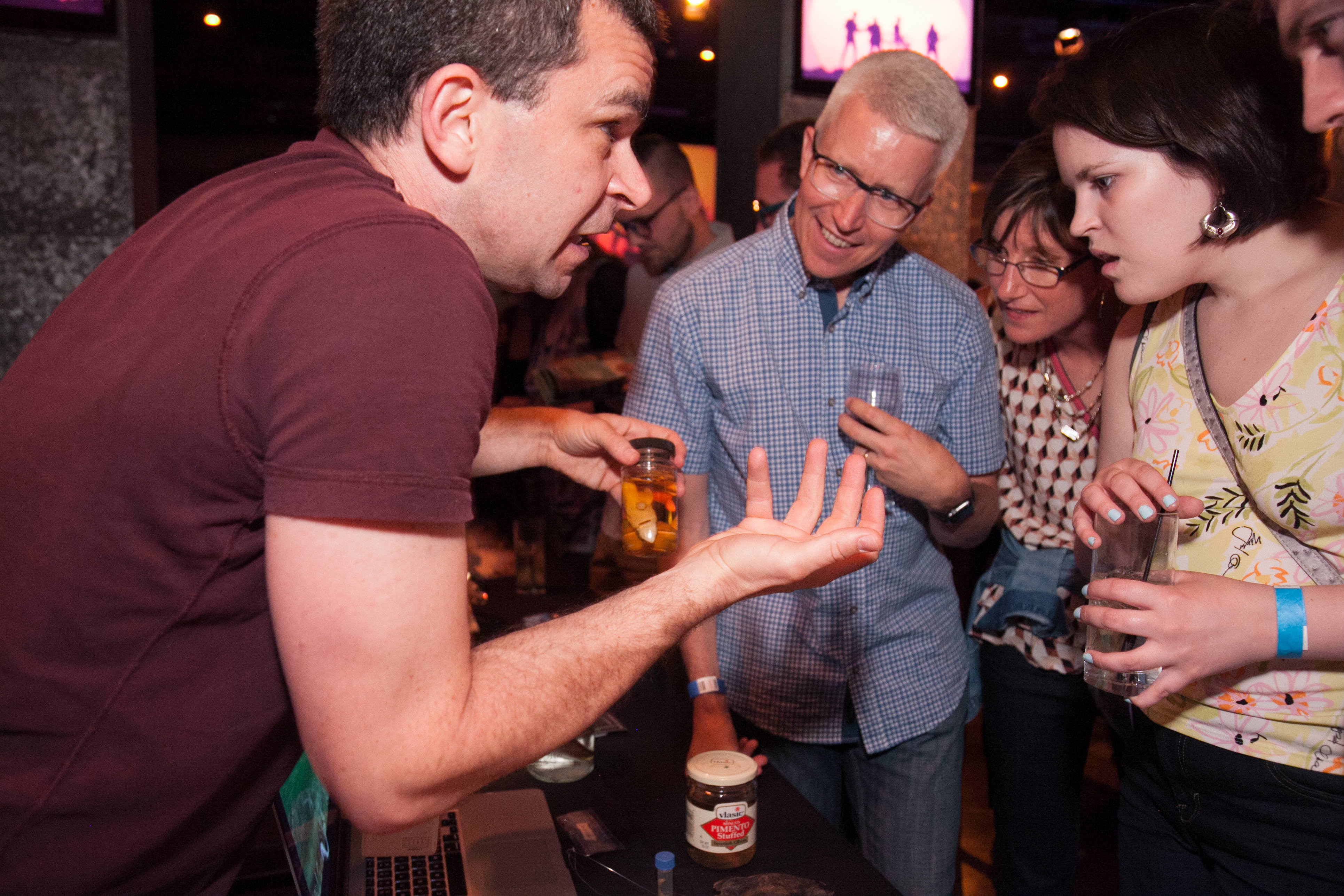People don’t usually go to Sidetrack—a popular Boystown club famous for its alcoholic slushies—to see beetles, spiders, and duck penises, but last night wasn’t the typical bar night.
In honor of Pride Month, the Halsted Street bar hosted Slushies and Science, organized by Field Museum’s LGBTQ group Outfielders, where nature’s more curious mating rituals were on display. The sold-out event donated all proceeds to the families of victims from the Pulse shootings.
Field Museum scientists brought their favorite specimens for display as visitors wandered around learning from each expert. At his table, collections manager Caleb McMahan picked up a preserved clown fish and told listeners that Finding Nemo misses one crucial fact: After Nemo’s mother dies, he said, Nemo’s father should have become a female.
Sex is fluid for clown fish, which are born gender neutral, he explained. They live in groups made up of an alpha female, an alpha male, and other juveniles. If an alpha female dies, the alpha male will become female and the next strongest male will become the alpha.
From gender swapping to virgin birth, the animal kingdom demonstrates that when it comes to sex, anything goes. What some consider an abomination is completely normal and commonplace to a penguin. That's the point of the event, according to Graham Troyer-Joy, an Outfielders member and front-end developer for the Field Museum. Outfielders wants to show that while same-sex relationships have been deemed unnatural by some, they’re very natural to other animals.
The day after the Pulse attack, the group decided to donate all the proceeds to the families of victims and bring the gay community together, to create "a deeper and more meaningful connection," Troyer-Joy said. Attendees seemed to agree. Erin McNulty came because it was “for a good cause,” but stayed to learn something, while Forrest Cortes—a self-described science nerd—came to both learn and support.
Other fun facts we learned from the night:
- Sneaky Blue Gills: Male blue gills will build nests in the sand where the female will eventually lay her eggs, McMahan says, but monogamy is not that easy. Smaller males will attempt fertilization without detection. “Sneaker males swim in, fertilize the eggs and go off,” he says.
- Awkward Duck Lessons: According to associate curator Shannon Hackett, a duck penis can grow to 20 centimeters in length and looks like a pink corkscrew. The males basically rape the female, which Hackett says can get awkward when high school students or undergraduates go on their first bird-watching trips. The female, however, has several false entrances to stop unwanted penetration.
- Penguins of Boystown: Hackett, the bird expert, says that approximately five to 10 percent of all penguins in zoos are gay.
- Virgin Shark Birth: Molecular lab manager Kevin Feldheim brought a pair of shark eggs, which look like shriveled pouches. Scientists recently discovered sharks are capable of giving virgin birth. Feldheim says female sharks can fertilize themselves when a male is not present and lay eggs.
- Vengeful Spiders: Associate curator Petra Sierwald brought a pair of brown widow spiders (don't worry, they were in vials), showing that the female is nearly twice the size of the male. Female brown widow spiders live close together, and Sierwald suspects it’s because they’re competing for males. When a female takes a male, he will live with her in her web and eat what she catches. When they mate, she will wrap him in silk, break his legs and discard him, possibly to stop other females from having his sperm, Sierwald explains. (Although black widows are known for killing the male after sex, Sierwald says only five or six of the 35 species of black widows actually do this. It’s the animal kingdom’s version of a one-night stand, and it’s evolution, as Sierwald says.)
- Bottle Fools Beetle: Collections manager Crystal Maier brought a stubby beetle, famous in Australia for a very strange reason. When a male stubby beetle looks for a female, it looks for the biggest, most dimply golden beetle it can find and mates with it. Australian beer bottles just happen to have that lush golden-brown color and bumps along the mouth, identical—to a male beetle anyway—to a female beetle. “They think they’re mating with the beer bottle?” one woman asked. “Only in Australia.”



